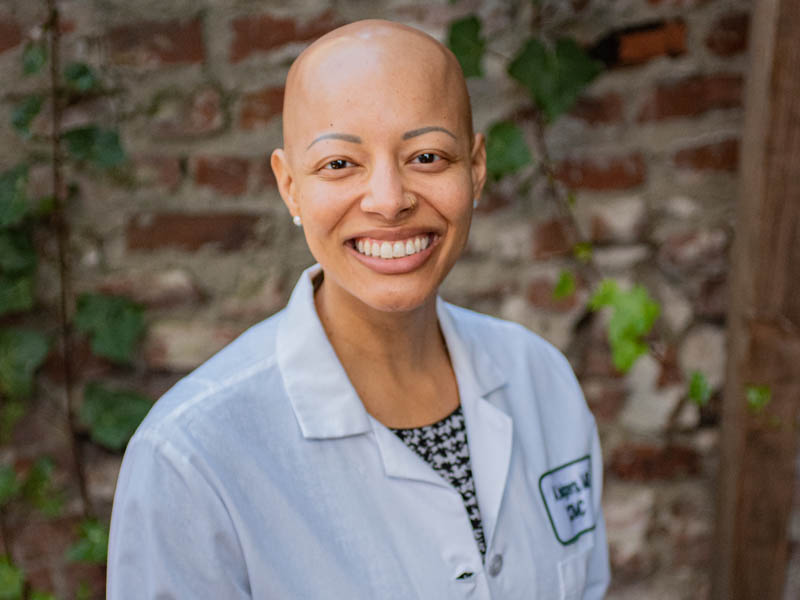Family Medicine and the Arts: A Conversation With Angela Rodgers, M.D., FAAFP

Feb. 29, 2024, News Staff — Interest in the arts runs deep for Angela Rodgers, M.D., FAAFP. Her great-grandfather Donald Mills was a member of the Mills Brothers, a groundbreaking jazz/pop vocal group that sold tens of millions of records between the 1920s and 1980s. Avenues like choir and theater helped Rodgers overcome the discomfort she felt after being diagnosed with alopecia areata early in life and gave her outlets where she could feel free and express herself to the world.
Now a staff physician in the Department of Emergency Medicine at Contra Costa Regional Medical Center; core faculty member and wellness lead at the Contra Costa Family Medicine Residency Program; assistant clinical professor in the Department of Family and Community Medicine at the University of California, San Francisco; and chair of Unity of Black Health Professionals in Excellence, Advocacy and Mentorship, Rodgers spoke with AAFP News about the relationship between the arts, family medicine and well-being.
Visit the AAFP’s Black History Month webpage to read the full conversation or listen to these highlights in this video interview:
Spontaneity in Artistic Performance and Doctor-Patient Engagement
“Depending on the type of performance, quite a lot of the arts are very scripted, well-rehearsed and practiced. This is something that gives a lot of comfort to quite a few people who are in the arts, but the really cool thing is that once you know your script, are well-rehearsed and practiced, there is this element of spontaneity and improvisation you can include in your performances. I feel like that piece is very much in line with medicine. … There is this typical illness script, as they call it in school, of how a patient will present to you, but patients don’t always read the textbook and we have to be able to pivot as we are encountering different ways in which patients are presenting and engaging with us. We must learn how to change our tone, our movement in the room, how we bring ourselves into the room, depending on patients and what they are presenting in front of us.”
Creativity and Physician Well-being
“It is essential for me to have some sort of creative process for my own well-being. As humans, we are made to be very curious and adventurous, and we want to continue to learn about the different things around us and ourselves. We want to explore. I think creativity in terms of my well-being means that my life is full of challenges at times … but that also leads to growth, which is a wonderful thing to experience as a human being. I also feel like there are times in which there are successes and times of joy and creativity, and I really feel like that allows me to be a humble person in terms of the challenges and growth that happens. It allows me to keep myself centered as I move forward in the world, not only in the hospital or in the clinic, but also as a human being out in society. It helps to keep me grounded. It allows me to interact with my patients in a deeper sense and bring my full self to the patient. It allows me to interact with my family, friends and colleagues in a way that is giving and less of a burden on the world. It helps me feel like I am bringing light and joy and happiness and goodness into the spaces I enter.”
How to Start Being More Creative in Practice
“First, give yourself grace. I think a lot of individuals who go into medicine care so deeply about people, about science and — for me — caring for those who are from historically marginalized communities. … There’s just so much that comes along with going into medicine. You want to do it all, and I feel like in society there sometimes can be this pressure that as a physician you're supposed to be doing it all and it lends to a sense that you have to be this superhuman individual who doesn’t have any of the typical needs of a human being, but doctors and physicians, we are humans. We have the same needs and wants as other people.
“Secondly, it is so important for you to find what brings you joy in life and follow that path in terms of finding ways to gradually incorporate creativity and art into your own practice and your own life.
“A couple of other pieces that are important are figuring out if you want to do something on your own or if you want to do something with other individuals. Some people prefer to be on their own and that’s when they get a chance to really think deeply about whatever activity they're doing and it just gives them a sense of security. Other times people want to be around others, but in medicine quite a bit you’re around others all day, and so sometimes it’s nice to be on your own. Another piece involves remembering your why, remembering your reason of why you want to incorporate this creativity into your own practice or life … I think it’s really important for you to continue to remember your why.”
Time for Creativity in a Busy Life
“When I think about creativity and arts, incorporating that into my profession or my life, sometimes it can feel like, ‘Oh man, I only have a little bit of time. Why do I want to spend more time doing this other activity when I could be studying or sleeping or exercising?’ It’s really important to think about what creativity brings into your life, why you want to initiate bringing creativity in your life and then why you want to continue whatever activity you choose.”